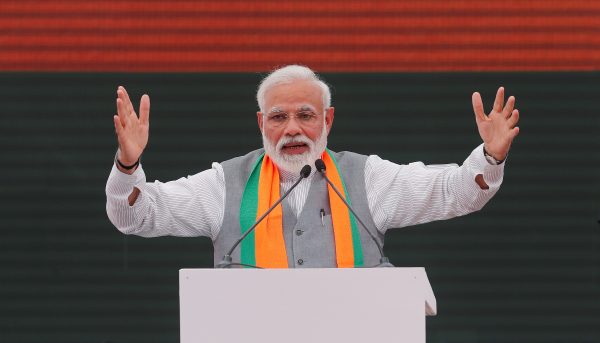The main promises included development (vikas) consisting of building infrastructure, encouraging manufacturing and creating smart cities and change (parivartan) of Indian society by eliminating corruption, cleaning up streets and rivers, and ending open defecation. In short, a BJP government would usher in ‘good times’ (achhe din).
Voters, disaffected by the lacklustre performance of the incumbent coalition government led by the Indian National Congress (INC) party, were attracted by those promises. The result was that the BJP secured a huge parliamentary victory swept along on a ‘Modi wave’.
But after unpopular policies such as the demonetisation of high-value banknotes, a shoddy implementation of the GST and failure to generate employment for India’s huge cohort of young people, the Modi wave seemed to be ebbing by the end of 2018 — as demonstrated by a poor showing in state elections.
In the national elections taking place between April and early May, the BJP is not highlighting a strong record of achievements in office — and there have been some significant ones. They have instead decided to run on national security issues, the promise to build a temple on the birthplace of Lord Ram in Ayodhya, and on Modi’s awarding himself the title of ‘watchman’.
The Indian National Congress (INC), which had hit rock bottom in the 2014 polls, staged a comeback by clinching some key victories in several state polls in late 2018. The INC campaigned around issues of farmer distress, a slowing economy and youth unemployment, and rode on a wave of anti-incumbency. A controversy concerning irregularities in a multi-million-dollar defence procurement contract for French-made Rafale fighter aircrafts gave the opposition an opening to get back at Modi’s image as an anti-corruption watchman.
In short, the race to Delhi had opened up.
Then, on 14 February 2019, an attack by a Kashmiri separatist in the town of Pulwama killed 40 Indian paramilitary personnel. Indian jets bombed an alleged terrorist target deep inside Pakistan and Pakistan retaliated with its own air attack on India. The Modi government and campaign machinery went into full swing, claiming credit for India’s surgical strikes and blaming the INC for years of soft-pedalling on the issue of fighting cross-border terrorism.
This event has certainly provided the government with a respite from the opposition questioning the government’s actions on its 2014 promises. But analysts disagree about how long the bump given by Pulwama will last and whether it will have an impact on voting behaviour come election time.
Over the last three decades India’s electoral scene has been dominated by coalition politics. The BJP’s strategists have been busy putting together key coalitions with important and like-minded state parties. The INC’s failure to build a coalition in 2014 allowed the BJP to convert its 31 per cent of the popular vote into a parliamentary majority. In the state of Uttar Pradesh the BJP won only 19 of 80 lower house seats by an absolute majority — it secured victory in 52 other seats because the opposition was divided.
In 2019, the INC can defeat the BJP by either putting forward winnable coalition candidates or rejuvenating its own cadre by giving its own candidates and local power brokers a shot at standing for the election. In states such as Delhi, Uttar Pradesh, West Bengal and Bihar there are good potential candidates that the INC has been either unwilling or unable to rope into a large coalition.
In Uttar Pradesh two major opposition parties have come to a pre-election agreement that only one will run directly against the sitting BJP candidate. Similar anti-BJP coalitions are being negotiated in other Indian states.
Recently, the INC also took some bold steps whose strategic worth will become clear only after the elections. For instance, to counter the ‘charisma deficit’ of its President, Rahul Gandhi, vis-a-vis Modi, the INC inducted his sister, Priyanka Gandhi, whose resemblance to their grandmother Indira Gandhi has some nostalgic appeal to rural voters. Also, to create a base in South India, where the BJP is weak, Rahul Gandhi has chosen to contest elections from a second seat (in addition to the traditional Gandhi seat of Amethi in North India) in Kerala’s Wayanad.
These moves, along with its reluctance to enter into pre-electoral coalitions, suggests that the INC is eyeing the second prize — it wants to consolidate its position as the main opposition party and, therefore, be a viable option to the BJP in 2024, if not in 2019.
Most of the parties opposing the BJP have a leader with aspirations to be prime minister if the anti-BJP coalition wins a majority of seats in the coming national elections. With so many potential opponents, the BJP’s public-relations machinery is faced with the prospect of fighting multiple opponents and not being able provide one clear narrative. So far, the best that they have done is call their opponents a band of thieves, united only by their hatred for Modi, who is denying them the corruption they are so used to feeding on.
But the opposition has also been unable to produce a clear account of what they will do if they are able to form a coalition government. At this stage the most likely outcome is that the BJP will be returned to power in May (with sharply reduced numbers) and be dependent on allied parties to form a government.
Mandar Oak is Associate Professor in Economics at the University of Adelaide.
Peter Mayer is Associate Professor and Visiting Research Fellow in Politics and International Studies at the University of Adelaide.

